
1755 DRAWN PLANTER
Drawn Planter
- Available in 1.6-bu. or 3-bu. MaxEmerge™ 5 row unit
- Insecticide option for 1.6-bu.
- 4-, 6-, and 8-row configurations
Maintenance Plans
Features
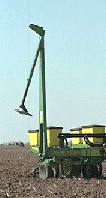 Folding marker
Folding marker
A 406-mm (16-in.) notched marker disk blade with a 102-mm (4-in.) wide depth gauging band is base equipment on folding markers. Notched marker disk blades are compatible with all tillage conditions but are recommended for no-till and high-residue mulch-till conditions. This marker uses a 44.45-mm (1.75-in.) square tube marker arm extension.
Folding markers are base equipment on the following planter model configurations:
- 1755 8Row30
- 1785 8Row30, 15Row15
Although not in base equipment, folding markers are available for the following integral planter configurations:
-
1705 6Row30, 6Row36, 6Row38, 6Row40, 8Row30, 8Row38, 8Row40, and all 10Row
-
1715 all rows
-
1735 all 12,13, and 15Row
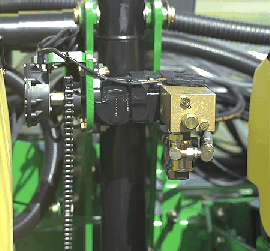 VRD shown on a 1775NT
VRD shown on a 1775NT
The seed variable-rate drive provides the ultimate planting productivity by utilizing one, two or three hydraulic motors (varies by model) to turn the seeding drive shaft. Hydraulic control of the seeding drive allows for on-the-go seeding rate changes right from the display mounted inside the tractor cab.
Combine this seeding flexibility with the map-based planting option, and seeding rates adjust automatically based on a prescription map.
Single- or dual-motor systems for variable-rate drives are available for all John Deere planters except the 1785 Rigid Frame. Dual- or three-motor drive systems are commonly used on larger (12-row and more) planters and offer the capability of half-width or three-section drive disconnect.
The VRD is available as a factory-installed option for all applicable planter models. Single- or dual-motor systems are available as field-installed attachments for most planter models; however, a three-motor VRD field-installed attachment is not available.
The seed VRD requires the SeedStar™ monitor and a radar input signal. Either tractor or planter radar may be used. Planter radar is ordered separately.
VRD offers the following advantages over common, contact-tire drive systems:
-
Almost instantaneous rate changes; there is no ramp up or ramp down of system as in some competitive systems
- Permits the operator to match seed population based on different soil types or irrigation practices
- John Deere design that provides added operator safety by eliminating any possible drive creep found in some competitive variable rate drive systems
Half-width drive disconnect
The half-width drive disconnect feature is excellent for the producer concerned with controlling seed costs. This feature helps the operator place seed in the desired area and limit the amount of costly overlapped planting.
The half-width drive disconnect allows the operator to turn off half of the planter at a time for planting end rows, point rows, etc. Variable-rate-equipped planters require two drive motors to utilize the half-width disconnect feature.
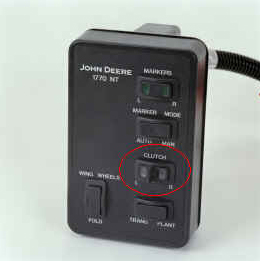 Half-width drive disconnect within frame control
Half-width drive disconnect within frame control
With a 1765, 1765NT, and 1775 12-Row Planter, a single switch box is required for planters that are ordered with variable rate drive and half-width disconnect.
For the 1775NT, 1775NT Central Commodity System (CCS™), and 1795 Front-Folding Planters, the half-width drive disconnect switch is contained within the frame control box, conveniently located in the tractor cab. The function easily shuts off the drive for the left or right half of the planter row-unit seed meters.
Three-width drive disconnect
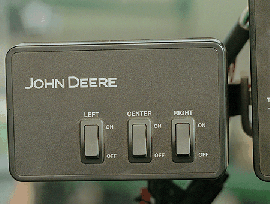 Three-width drive disconnect control
Three-width drive disconnect control
Three-width drive disconnect is an option on 1725 12-Row Planters and is base equipment on the 1725 16Row30 Planter. This feature is activated by three individual console mounted switches (control box), conveniently located in the tractor cab. The function easily shuts off the planter row-unit seed meters by one-, two-, or three-drive segments independently.
Integrated innovation--that is what operators will appreciate with the SeedStar 2 monitoring system and GreenStar™ 2 (GS2) Display. An increasing number of acres combined with rising seed costs drive the need to easily understand planter functions and monitor performance. It is all about making every seed count and that is what SeedStar 2 delivers.
The SeedStar 2 monitoring system is a full-feature, color, seed population monitor used in conjunction with the GreenStar family of displays (Generation 4 CommandCenter™ controls with premium activation, GS 2630, GS 2600 Display or the entry-level GS2 1800 Display). Conveniently, SeedStar 2 planting functions are fully integrated with the full spectrum of AMS applications—guidance, coverage maps, and field documentation can be shown all on one display.
When a SeedStar 2 system is used on a planter, there is no need for a ComputerTrak™ monitor. All vital planting information is displayed in one central, easy-to-read location.
SeedStar 2 features
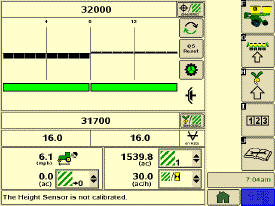 SeedStar 2 full-screen planter run page
SeedStar 2 full-screen planter run page
SeedStar 2 is a user-friendly system that has retained all the valued features of SeedStar and incorporated the next generation of enhancements. For example, on-screen, color indicators shows drive engagement/disengagement status. In addition, three color (black, orange, or red) planter at a glance bars visually inform the operator of row population status.
Not only does SeedStar 2 incorporate the use of color, it also utilizes an intuitive icon and folder based operator interface. Icons are easy to understand across many languages and reduce the need for text. Icons for planter main run page, planter setup, seed/crop setup, totals, and diagnostics are located in the soft-key region of the display. Setup is performed by selecting the appropriate icon and then choosing the tabs to enter/select information.
The SeedStar 2 monitor offers all of the features and functionality of the ComputerTrak™ 350 monitor and much more. SeedStar 2 monitors the following planter functions:
- Row population/spacing
- Row failure
- Average population (entire planter and by variable-rate drive [VRD] motor section)
- Vacuum level
- Fertilizer pressure
- Acre counter
- Total acreage
- Tractor speed
In addition, planter operational information is available within the SeedStar 2 monitor system. Such operational information includes population charts, seed disk vacuum settings, and setting recommendations for the piston pump liquid fertilizer system.
All SeedStar 2 systems have the capability, through a single controller, to perform both the seed monitoring and variable rate drive functions. SeedStar 2 monitoring is required for VRD population control. Even though the planter may not be equipped with SeedStar 2 VRD, the SeedStar 2 monitoring system is available and will allow for future installation of VRD.
SeedStar 2 enhancements
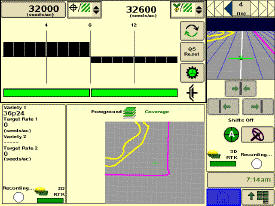 SeedStar 2 half-screen planter run page
SeedStar 2 half-screen planter run page
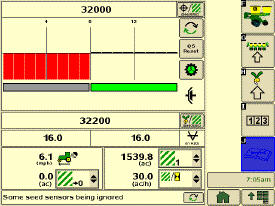 SeedStar 2 showing half-width disconnect status
SeedStar 2 showing half-width disconnect status
The SeedStar 2 enhanced planter features include:
- GreenStar 2 display integration. Eliminates the need to operate the GS2 2600 Display in the original GreenStar monitor mode or the use of dual displays.
- User-friendly, intuitive icons
- Half- or full-screen run page
- On-screen, color drive status; a quick glance at the display tells the operator if the half-width disconnect is engaged or disengaged.
- Three-color planter-at-a-glance population bar. A black bar indicates that population is close to target and within established limits; orange shows the population is above/below the alarm set point; red signals the population is out of operating range or is not planting.
- Three-piece, color VRD indicator. Each piece of the VRD gear pie turns green when the wheel motion sensor is active, planter is lowered, and drives are engaged.
SeedStar monitoring original features
SeedStar 2 retains all those SeedStar features that producers value and have come to expect:
-
Planter at a glance. Allows operator to view relative population levels of all rows on one screen.
-
Automatic valve calibration. With the SeedStar VRD, this is now completed automatically. There is no longer a need to manually calibrate the hydraulic valves.
-
Increased population updates. SeedStar will now update population levels once a second at planter start up then approximately once every three seconds.
-
Mapping of actual seed rates. When combined with Field Doc™ system, actual and target seeding rates can now be mapped in Apex™ software.
-
Reprogrammable utilizing CAN via Service ADVISOR™ diagnostics system.
-
Improved diagnostics/event recorder. On SeedStar VRD planters, additional diagnostic information is available, as well as an event recorder to capture system performance data at a specific point in time.
-
Ability to run motors at different population levels. On SeedStar VRD, operators running multiple motor systems can run each motor at a different speed, allowing different population levels within a planter.
-
User-configurable high fertilizer pressure alarm. Allows the operator to be warned when fertilizer pressure reaches a specific level.
-
Automatic quick-start for SeedStar VRD. No longer does the operator need to press the quick-start button on end row turns to resume planting.
-
Automatic tractor speed source selection. When equipped with an 8000/9000 Series Tractor, the system selects the radar speed or allows for manual speed input selection.
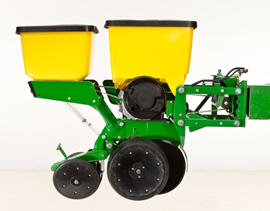 MaxEmerge 5 with 56-L (1.6-bu) hopper plus insecticide
MaxEmerge 5 with 56-L (1.6-bu) hopper plus insecticide
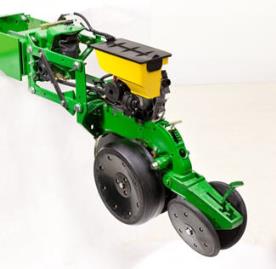 MaxEmerge 5 with mini hopper on CCS™ machines only
MaxEmerge 5 with mini hopper on CCS™ machines only
The MaxEmerge family of row-units have never seen a more versatile and efficient design until the MaxEmerge 5. The 5-family row-units improve productivity, increase uptime and lower the cost of ownership like never before.
The MaxEmerge 5 row-unit was designed for improved performance and serviceability.
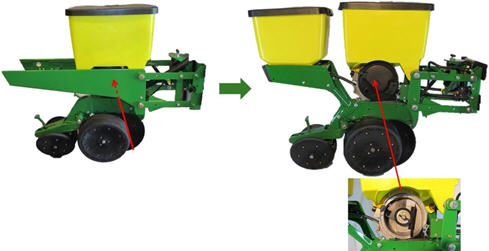

Serviceability and changing crops has always been a focus of downtime and potential seed loss. MaxEmerge XP row-units (shown on the left) are designed with the meter and hopper as one component. The frame covers the meter so that it cannot be accessed. Cleanout of excess seed requires the operator to take the entire hopper off of the row-unit and to turn it upside down. The MaxEmerge 5 meter (shown on the right) is accessible without having to remove the box. The MaxEmerge 5 design allows large hoppers to be cleaned out the same as mini-hoppers, simply by opening the meter dome and catching the seed as it falls out. This improvement allows operators to change seed varieties easier and three times faster than it took them on the previous MaxEmerge XP units and provides more uptime during the tight planting window.
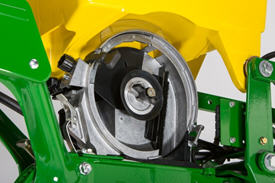 MaxEmerge™ 5 vacuum seed meter
MaxEmerge™ 5 vacuum seed meter
The vacuum meter system gently pulls and holds individual seeds to the holes of the seed disk for population control and spacing accuracy, equaling better crop stands and profit. Vacuum seed meters can plant a wide variety of crops and seed types by simply changing seed disks and adjusting vacuum level. Vacuum seed meters are available for planters with MaxEmerge 5 row-units.
Additional features of the vacuum seed meter include:
- One moving component (the seed metering disk) for minimum maintenance requirements
- Meter located at each row-unit for accurate seed delivery
- Good hopper seed flow characteristics for longer operating time per hopper fill
- Low airflow in meter so seed treatments are not removed
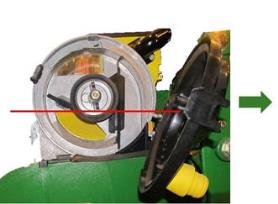 Pro-Series™ seed pool
Pro-Series™ seed pool
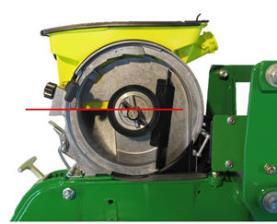 MaxEmerge 5 seed pool
MaxEmerge 5 seed pool
The MaxEmerge 5 meter shape has also been redesigned for better seed flow. The mini-hopper design allows the planter to successfully operate on side hills up to 14 degrees.
Vacuum meter hub and latching handle
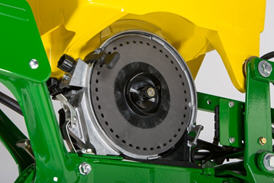 MaxEmerge 5 vacuum meter with disk
MaxEmerge 5 vacuum meter with disk
Both the MaxEmerge 5 vacuum meters are equipped with a heavy-duty hub spring and disk latching handle. The spring ensures the seed disk stays properly positioned when operating flat-style seed disks and higher vacuum levels. Proper seed disk positioning means repeatable seed singulation, time after time. The disk-latching handle is designed for easy operation and effortless seed disk changeover. The hub is also machined to tight tolerances to further ensure alignment of metering components.
Operating characteristics of vacuum seed meter
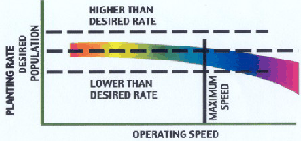 Operating speed with seed tube technology
Operating speed with seed tube technology
The vacuum seed meter is capable of operating at faster planting speeds than mechanical meters. However, planting accuracy will be influenced by seedbed conditions and the operating characteristics of the seed meter. Rough seedbeds and fast planting speeds (above 8.9 km/h [5.5 mph]) typically deteriorate seed placement accuracies when using seed tube technology.
The chart illustrates the effect operating speed has on population when using the vacuum meter. The operating band (color area) illustrates how the vacuum meter performs in relation to the desired population (indicated by horizontal line). The width of the band is due to various sizes and shapes of seeds and planting rate variations.
When operating on slopes above 15 degrees, increased or decreased population may result. To minimize this effect, reduce speed and consider using a flat style seed disk with increased vacuum level.
Vacuum meter seed disks
The ProMAX 40 Flat Disk: The flat-disk planting solution field-proven to work since 1991
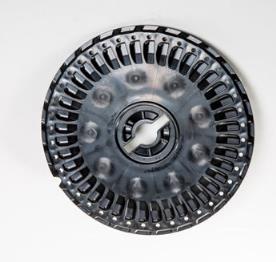
The design of the ProMAX 40 Flat Disk position allows seed to be released from the optimum position above the seed tube. The flush-face seed tube allows the seed to drop uninterrupted through the tube.
The ProMAX 40 Flat Disk utilizes flat holes and a higher vacuum level to ensure every hole is populated with a seed. A double eliminator gently removes multiple seeds at each hole for precise population control. A knockout wheel makes certain that each hole is clear of any debris after the seed is released from the disk.
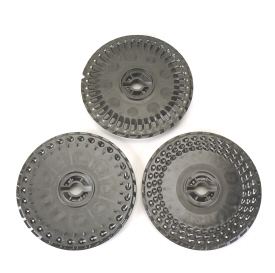 Flat-style and cell seed disks shown
Flat-style and cell seed disks shown
The unique cell disk design allows planting a variety of seed sizes without any additional parts or individual meter adjustments. Another advantage of cell-type seed disks is the lower vacuum requirement compared to flat-style seed disks. Lower vacuum levels mean less hydraulic demand from the tractor. Most planting conditions call for a flat disk, if you are limited in hydraulic capacity, cell disks are recommended.
Double eliminator
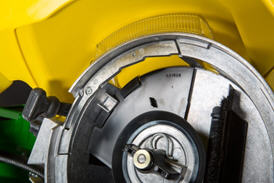
For difficult to singulate seeds, a flat seed disk and double eliminator is a viable alternative to traditional cell-type seed disks. By design, a flat seed disk requires higher levels of vacuum than a cell-type disk because there is no pocket or cell to hold the seed. The higher vacuum level will pull more than one seed to the holes in the seed disk. The double eliminator is set to cover a portion of the hole in the seed disk and is the mechanism to knock multiple seeds away as the disk rotates.
Double eliminators are required with flat-type seed disks only and should not be used with cell-type seed disks. The knockout wheel is also recommended in conjunction with the double eliminator and flat seed disk to ensure seed is ejected from the disk.
Flat and celled type seed metering disks are available to allow planting a wide variety of seed types.
- Corn (field, popcorn or sweet corn)
- Soybeans
- Cotton
- Sorghum
- Sugar beets
- Sunflowers
- Edible beans/peas
- Peanuts
- Melons, squash, cucumbers
Mini-hopper row-units, which are used only with the Central Commodity System (CCS™) are compatible only with crops that the CCS is approved to plant.
- Corn
- Popcorn
- Sweet corn
- Soybeans
- Sunflowers
- Sorghum
- Cotton
NOTE: Due to small seed size and low planting populations, sugar beets can be planted with mini-hopper style meters by adding hopper extensions and not using the CCS tank. These hopper extensions can also be used for planting test plots.
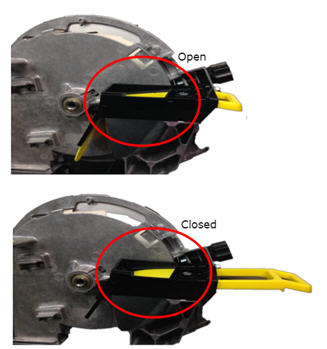 Hopper shutoff
Hopper shutoff

Also, to help with meter access of 56-L and 106-L (1.6-bu and 3-bu) hoppers the hopper shutoff feature was added. With the shutoff engaged, the meter cover can be opened without first having to remove all of the seeds from the hopper. Lever down, the seed flow is on, lever horizontal and the seed flow is off.
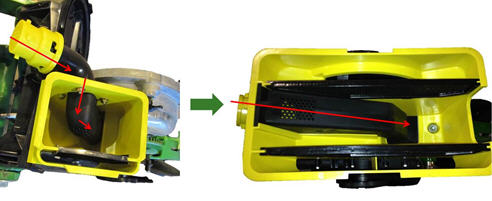 MaxEmerge 5 mini-hopper
MaxEmerge 5 mini-hopper

There are significant changes to the MaxEmerge 5 Mini-Hopper. One update is the straight feed from the Central Commodity System (CCS™) hose to the mini-hopper to ensure a continuous free flow of seeds. This design change reduces the potential for plugging issues with larger seed size and the use of seed treatments. By drawing air from the CCS tank the vacuum source is now cleaner, preventing meter debris buildup.
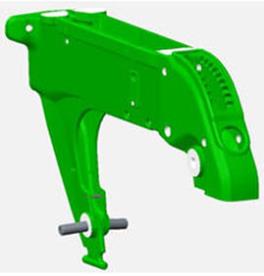 Ductile iron-cast shank
Ductile iron-cast shank

Ductile iron casting is a unique high-tech process that produces a single-piece row-unit shank this enables alignment from the seed trench to the closing wheel.
The row-unit head is also designed using the ductile iron-casting process. The row-unit head provides the mating joints between the row-unit parallel arms and the row-unit shank. It is also the upper attaching point for the seed meter and seed hopper.
Ductile iron casting of the row-unit shank and head assembly provides a row-unit that is 25 percent stronger than other competitive welded row-units.
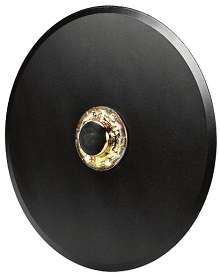
One of the trademark capabilities of John Deere planters has always been the ability of the Tru-Vee™ openers to provide an ideal seed furrow.
The thickness of the Tru-Vee opener blade is 3.5 mm (0.14 in.) this blade thickness will provide extended wear life.
The MaxEmerge 5 row-unit also provides better Tru-Vee opener bearings for longer life. The double-row ball bearing provides up to three times the wear life as the single-row bearing.
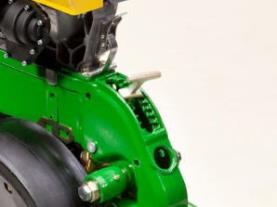 Depth adjustment T-handle
Depth adjustment T-handle

John Deere planters provide consistent seed depth control in all field conditions. Depth control is a function of the Tru-Vee openers, the downforce system, and the gauge wheel assembly.
The gauge wheel itself is made of durable nylon composition with a concave profile. This profile gently firms the sides of the seed furrow, ensuring a well-defined trench. The shape reduces rocks and residue being picked up and thrown onto the drive chains and row-units, and helps to prevent rooster tailing of soil.
The bolt-through design utilizes an open bearing in the gauge wheel that allows an attaching bolt to pass through the wheel to the threaded hole in the gauge wheel arm. This simple bolt-through design provides for a positive attachment of the gauge wheel to the gauge wheel arm and allows quick removal of the gauge wheel for service.
Adjustability of the row-unit is critical to good performance. More available downforce options than any row unit in the industry
- Adjustable heavy-duty downforce, four settings, 0 kg (0 lb), 57 kg (125 lb), 113 kg (250 lb), and 181 kg (400 lb) of downforce
- Pneumatic downforce, infinitely variable from 0 to 181 kg (0 to 400 lb) of downforce
- Active pneumatic downforce adjusts automatically for changing ground conditions from 0 to 181 kg (0 to 400 lb) of downforce
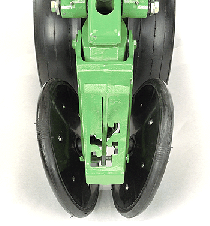 Rubber tire closing system
Rubber tire closing system
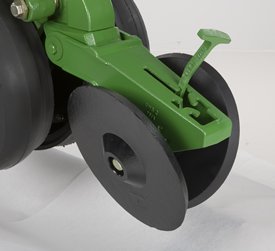 Cast wheel closing system
Cast wheel closing system
Rubber tire closing systems are used for most conventional, minimum-till, and no-till planting conditions. The spacing between the wheels is adjustable so the closing system can meet the needs of those who want to plant small seeds at shallow depths.
The wheels can also be staggered fore and aft to enhance residue flow. Four levels of spring force are available and are easily set with the integrated T-handle adjustment. A lower force spring can be obtained from parts, if a lower amount of force is required.
Additional closing wheel options include:
- Cast closing wheels, for tough-to-close conditions
- Disk closing, for shallow planting depths
- Closing wheel frame less wheels, for growers desiring to use aftermarket closing wheels
Block manifold delivery system
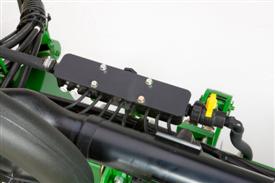 Block manifold distribution
Block manifold distribution
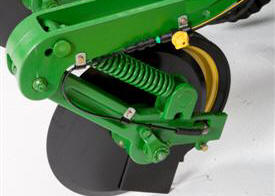 Orifice and check valve to the opener
Orifice and check valve to the opener
Delivering consistent and accurate fertilizer rates to each row is critical with any liquid fertilizer delivery system. The John Deere liquid fertilizer system utilizes 12-port block manifolds to equally distribute flow to the opener or in-furrow method of application. Liquid is distributed to each row through an 8-mm (0.3-in.) hose.
There are check valves at each row to ensure the system remains primed and flow stops immediately when planter is lifted. An orifice is located in-line and provides the restriction needed to achieve desired system pressure for excellent rate accuracy.
This delivery system will operate between 15 psi and 90 psi, depending on the orifice size and rate. System pressure should not exceed 100 psi. Four orifice sizes allow operators to achieve a variety of rates all with optimal system performance and row to row accuracy. See rate chart below for model by model minimum and maximum application rates.
An 80-mesh washable screen is in place between the tank and the pump. It is essential to have this screen (AA40216) and associated fittings in place ahead of the fertilizer pump even if not using a factory tank and quick-fill system. This screen is utilized to catch any blocks in the system caused by liquid fertilizer impurities. It is not recommended to use the 50-mesh screen.
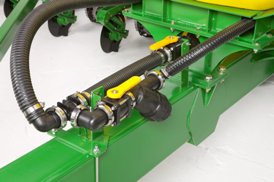 80-mesh screen and fittings
80-mesh screen and fittings

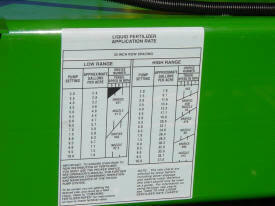 Fertilizer rate chart located on planter
Fertilizer rate chart located on planter

Refer to this chart or the operator’s manual for fertilizer rate settings.
Model |
Maximum rate (gal./acre) |
Minimum rate (gal./acre) |
1705, 1715, 1725, 1755, 1765, 1775NT 12R, 1775NT 16R - 76 cm (30 in.) |
37.6 |
2.4 |
1705, 1715, 1755 - 91.44 cm (36 in.) |
31.3 |
2.0 |
1705, 1715, 1755 - 97 cm (38 in.) |
29.7 |
1.9 |
1705, 1715 - 102 cm (40 in.) |
28.2 |
1.8 |
1785 - 76.2 cm (30 in.) |
41.8 |
2.6 |
1785 - 91.44 cm (36 in.) |
34.8 |
2.2 |
1785 - 96.52 cm (38 in.) |
33.0 |
2.1 |
1775NT 24R Fixed-rate pump |
31.0 |
3.2 |
1795 |
28.4 |
3.3 |
DB44 24R22 |
20.0 |
4.0 |
DB58 32R22 |
14.0 |
4.0 |
DB60 24R30 |
14.0 |
3.0 |
DB60 47R15 |
14.0 |
5.0 |
DB60 36R20 |
14.0 |
4.0 |
DB66 36R22 |
12.0 |
4.0 |
DB80 48R20 |
10.0 |
4.0 |
DB88 48R22 |
10.0 |
4.0 |
DB90 36R30 |
8.0 |
3.0 |
DB80 32R30 |
8.0 |
3.0 |
DB120 48R30 |
7.0 |
3.0 |
NOTE: 1.2-mm (0.04-in.) yellow orifices and 1.7-mm (0.07-in.) black orifices are included with this system from the factory. For producers wanting to apply higher or lower application rates, two additional orifice sizes are available through Service Parts; 0.7-mm (0.03-in.) green (A91474) and 2.5-mm (1-in.) grey (A91478). Refer to rate charts in the operator’s manual or decal for details.
Field install kits
The John Deere liquid fertilizer system is also available as an attachment for field conversion on many models.
Fertilizer pump and opener options
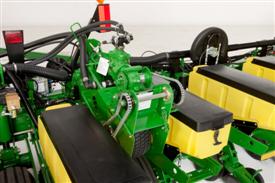 Fixed-rate CDS-John Blue® piston pump
Fixed-rate CDS-John Blue® piston pump

This liquid fertilizer delivery system is compatible with the fixed-rate pump. The system can be ordered with openers or less openers, if in-furrow application will be used. If ordered fewer openers, hoses with check valves and orifices installed will be tied up at each row for producers to finalize routing.
Flow monitor
If producers want to add a visual flow monitor to this system, John Deere has formed an allied agreement with CDS-John Blue to meet this need. Please contact CDS-John Blue for flow monitor options.
CDS-John Blue Company, Division of Advanced System Technology, Inc.
PO Box 1607, Huntsville, AL 35807
Tel: 800-253-2583, 256-721-9090
Fax: 256-721-9091
Email: info@cds-johnblue.com
www.cds-johnblue.com
CDS-John Blue is a trademark of CDS-John Blue Company.
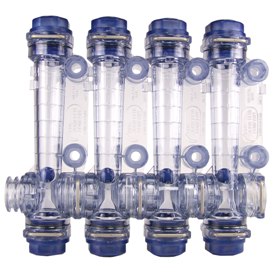 CDS-John Blue Visa Gage II liquid flow-rate monitor
CDS-John Blue Visa Gage II liquid flow-rate monitor
Granular fertilizer hopper and transmission
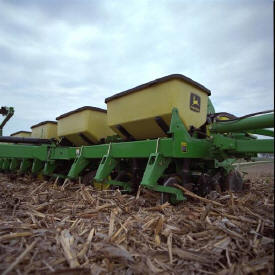 Granular fertilizer hopper and opener
Granular fertilizer hopper and opener
Granular fertilizer is available for 1755, 1775, and 1785 Planters. Fertilizer hoppers/tanks and selected other equipment may not be installed to facilitate shipping. Fertilizer attachments place fertilizer only on 76.2-, 91.4-, or 96.5-cm (30-, 36- or 38-in.) spacings. Some planter frame and row spacing combinations result in the opener offset from 10.1 to 15.2 cm (4 in. to 6 in.) of the centerline of the Tru-Vee™ opener.
Hoppers hold approximately 249.5 kg (550 lb) of fertilizer for longer operating time between fill-ups. One hopper feeds two rows. Hopper lids provide large opening for fast filling with less spillage. Hoppers pivot for easy dumping and cleaning.
Transmission (two on 1775) has 24 sprocket combinations in consistent 6 percent increments to allow applying fertilizer at the desired application rate. Depending on which auger is selected, a wide range of fertilizer rates can applied from 21 kg/ha (47 lb/acre) to 325 kg/ha (717 lb/acre). Requires openers or surface application bracket.
Augers for granular fertilizer system
Low-, regular-, or high-rate feed augers are required to complete the granular fertilizer system. Augers move fertilizer from the fertilizer boxes to the opener. Regular- or high-rate augers are matched with the opener style selected and are available as a factory-installed option or as an attachment for field conversion. Low-rate augers are only available as an attachment for field conversion.
For 30-in. rows the approximate rate of application is as follows
-
Low-rate augers 21.3-56.2 kg/ha (47 - 124 lb per acre)
-
Regular-rate augers 42.6-215.9 kg/ha (94 - 476 lb per acre)
-
High-rate augers 74.4 kg-325.2 kg/ha (164 - 717 lb per acre)
For 38 inch rows the approximate rate of application is as follows
-
Low-rate augers 16.8 kg-84.4 kg/ha (37 lb per acre-186 lb per acre)
-
Regular-rate augers 33.6 kg/ha-169.2 kg/ha (74 lb per acre-373 lb per acre)
-
High-rate augers 50.3 kg/ha-253.6 kg/ha (111 lb per acre-559 lb per acre)
NOTE: Weight metered may vary from that indicated because the fertilizer attachment will meter by volume not by weight and because of differences in fertilizer density
1755 and 1785 granular fertilizer openers
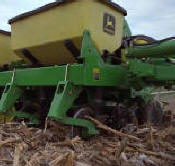 Granular fertilizer opener
Granular fertilizer opener
Frame-mounted, double-disk openers and frame-mounted single-disk openers for granular fertilizer are available on the 1755 and 1785 Planters. The frame-mounted single-disk opener is available with a regular spout or cast spout. Fertilizer openers place the granular fertilizer into the soil for maximum plant uptake and are adjustable. Single-disk fertilizer openers are required for no-till, but are also suitable for conventional and reduced tillage. Double-disk fertilizer openers should only be used in conventional and reduced tillage conditions.
-
Single- and double-disk openers are compatible with frame-mounted coulters.
-
Single-disk opener with cast spout is recommended for all soil conditions because it keeps soil from flowing into the furrow before fertilizer is delivered.
-
Gauge wheel on single-disk openers will help gauge fertilizer application depth and minimize soil disruption.
-
On 1755 8Row30 Planters, due to frame limitations, the granular fertilizer systems with single-disk openers can place fertilizer no closer than 12.7 cm to 15.2 cm (5 in. to 6 in.) to the seed furrow on rows 4 and 5.
1770 granular fertilizer openers
Frame-mounted, single-disk fertilizer openers with cast spout are utilized on the 12Row30 1775 Planter. These openers are ideal for both conventional and no-till. The openers are adjustable to place the fertilizer in the soil next to the seed furrow for ideal nutrient placement and maximum plant uptake. A single gauge wheel allows the opener to follow the contour of the ground for ideal fertilizer depth placement. Single-disk fertilizer openers are compatible with frame-mounted coulters.
Pneumatic downforce provides convenient, simple adjustment of downforce for the whole planter from one location. The amount of downforce applied is infinitely adjustable from 0 kg to 181.80 kg (0 lb to 400 lb). Pneumatic downforce provides more consistent downforce throughout the range of row-unit travel than mechanical spring downforce systems.
Several pneumatic downforce system improvements have been implemented, including:
- 9.5-mm (3/8-in.) air delivery line instead of the 6.4-mm (1/4-in.) line used on model year 2010 and older planters.
- Air compressor assembly increased duty cycle. With this compressor, it provides a 47 percent increase in maximum air flow delivery compared to the prior air compressor.
- Pneumatic air bags with 9.5-mm (3/8-in.) air line inlets that have greater durability.
Such improvements to the pneumatic downforce system enable faster and more precise control of row-unit downforce while planting.
System features
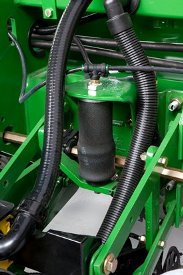 Pneumatic downforce spring
Pneumatic downforce spring

Each row-unit has a single, rubber air bag located between the parallel arms. The air bags are hooked in parallel so that air can be added or released from all rows at once from one location.
Pneumatic downforce systems are available as base equipment on all 1700 Series and DB Planters. The individual pneumatic downforce air bag assemblies, air compressor units, and 9.5-mm (3/8-in.) delivery lines are also available as an attachment for field conversion.
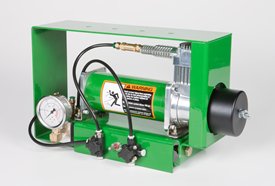 Pneumatic downforce compressor and gauge
Pneumatic downforce compressor and gauge

An improved compressor is used to charge the pneumatic system. This compressor can be located on the planter frame or in the tractor cab if desired. A gauge at the compressor indicates the amount of downforce being applied.
From the factory, integral planter models with pneumatic downforce will have an improved air compressor assembly with an in-cab mounting bracket, except the 1725 16-row and 1725 Central Commodity System (CCS™ ) Twin-Row Planters will have the air compressor assembly mounted on the planter frame. For drawn planter models, the 1755, 1765, 1765NT, 1775 Front-Fold, and 1785 Drawn Planters will have the air compressor assembly installed either on the outer hitch or wing frame members when the pneumatic downforce system is installed.
Crop yields have increased through the years along with the amount of residue left in the field after harvest. At the same time, tillage practices have changed, including different tillage operations which maintain large amounts of surface residue, and even no till practices. Row cleaners are an essential tool in managing this increased amount of residue.
John Deere seeding group offers a variety of row cleaner options to meet the needs of a producer's operation. Compatibility varies by model, row spacing, and other planter equipment.
Screw-adjust unit-mounted row cleaner
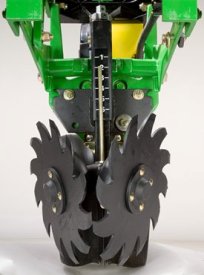 Screw-adjust unit-mounted row cleaner
Screw-adjust unit-mounted row cleaner
The screw-adjust unit-mounted row cleaner is mounted directly to the face plate of the row-unit, placing the ground engaging components just in front of the row-unit opener blades and depth gauge wheels. This close proximity allows the gauge wheels to control the depth of the row cleaner as well as the row-unit. This compact design also allows greater compatibility with fertilizer openers and other planter attachments.
SharkTooth® wheels are standard equipment on the unit-mounted row cleaner. The swept-tooth design of the wheel provides a clear path for the row-unit openers while resisting residue buildup on the wheel. The screw adjustment knob is accessible through the top of the parallel arms, providing convenient access for adjustments. The row cleaner can be adjusted in 1.6-mm (0.06-in.) increments, providing plenty of flexibility to meet the needs of changing conditions.
Floating row cleaner with unit-mounted coulter
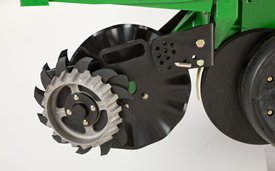 Floating row cleaner with unit-mounted coulter
Floating row cleaner with unit-mounted coulter
The floating row cleaner allows a row cleaner to be used in conjunction with a unit-mounted coulter. This combination is often desired in heavy residue loads and tough reduced tillage planting conditions. The row cleaner provides a clear path for the row-unit, while the unit-mounted coulter helps penetrate tough soil conditions.
Accommodating the unit-mounted coulter means the residue wheels are farther forward from the row-unit face plate than in the case of the screw adjust row cleaner. To maintain performance, this row cleaner has the capability to float above a defined minimum depth.
Standard depth-gauging bands on the wheels allow the row cleaner wheels to float independently of the row unit openers, allowing both to perform in varying terrain. The unit may also be set in a fixed position by simply pinning through the bracket if desired. This row cleaner also features SharkTooth wheels as standard equipment.
The floating row cleaner and unit-mounted coulters are available on many planters as factory-installed equipment. As compatibility and details vary by model, review the following links for information on specific planter models.
SharkTooth is a trademark of Yetter Manufacturing.
NOTE: Screw-adjust row cleaners are not compatible with MaxEmerge™ 5e row-units with long parallel arms.
NOTE: DB models have the option for either unit-mounted coulter, screw-adjust row cleaners, or pneumatic row cleaners (only compatabile with MaxEmerge 5e or equipped ExactEmerge™ models). The DB60T is only available with less row cleaner option.
Seed variable-rate drive provides the ultimate planting productivity by utilizing one, two, or three hydraulic motors (varies by model) to turn the seeding drive shaft. Hydraulic control of the seeding drive allows for on-the-go seeding rate changes right from the display mounted inside the tractor cab. Combine this seeding flexibility with the map-based planting option, and seeding rates adjust automatically based on the prescribed map.
Variable-rate drive offers the following advantages over common, ground, or contact-tire drive systems:
-
Rate changes are almost instantaneous; no ramp up or ramp down of system as in some competitive systems
- Permits the producer to match seed population based on different soil types or irrigation practices
- John Deere design provides added operator safety by eliminating any possible drive creep found in some competitive variable-rate drive systems
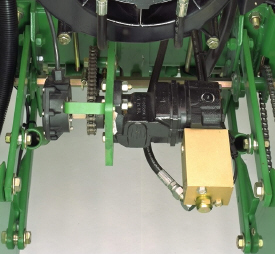 1755 equipped with variable-rate drive
1755 equipped with variable-rate drive
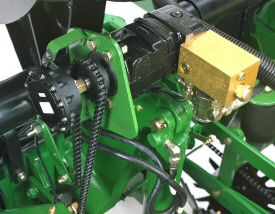 1765NT equipped with variable-rate drive
1765NT equipped with variable-rate drive
Single- or dual-motor systems for variable-rate drives are available for all John Deere planters except the 1785 Rigid Frame. Variable-rate drive is available as a factory-installed option for all applicable planter models.
Single- or dual-motor systems are available as field-installed attachments for most planter models; however, a three-motor variable-rate drive field-installed attachment is not available.
Seed variable-rate drive requires the SeedStar™ monitor and a radar input signal. Either tractor or planter radar may be used. Planter radar is ordered separately.
NOTE: Peanut seed meter disks require the Variable Drive Transmission.

